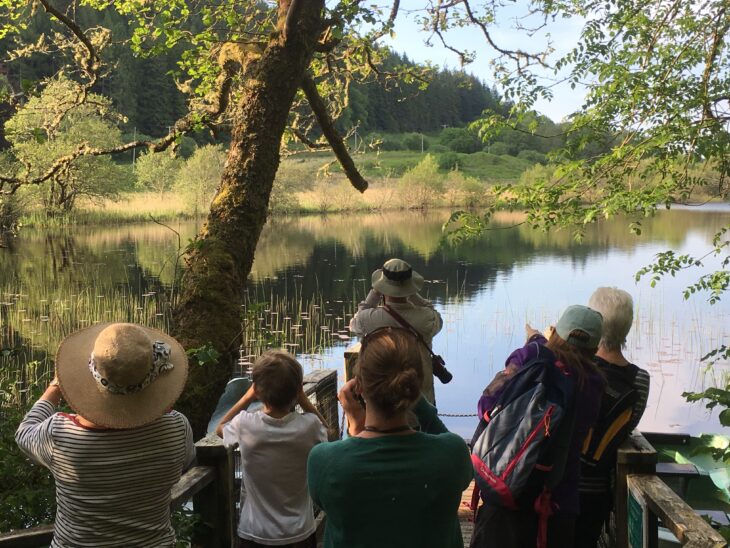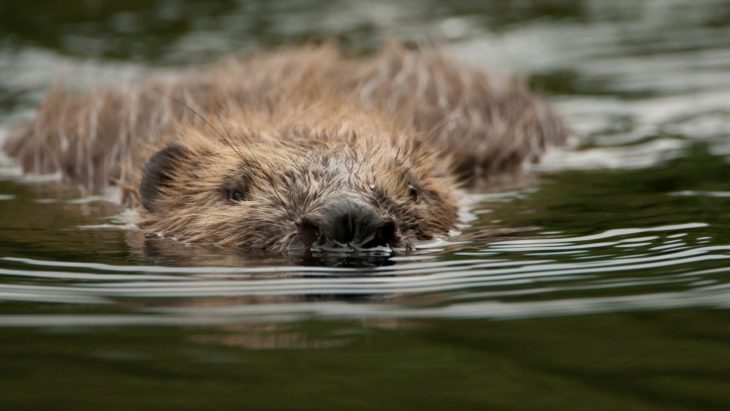Why beavers are a keystone species for wildlife tourism in Knapdale
In this guest blog, Pete Creech from the Heart of Argyll Wildlife Organisation explains how beavers have become a magnet for visitors to mid-Argyll, and helped create a wider interest in the area’s wildlife.

If you visit Knapdale and its surrounding shores you have a very good chance of encountering most of Scotland’s iconic species.
We’re fortunate to work in an area with so much special wildlife. Pine martens, red squirrels, ospreys, golden eagles, harbour seals, otters, basking sharks, minke whales, red deer, white-tailed sea eagles, adders, puffins; the list is a very long one.
The reason for this rich range of wildlife is the diversity of landscapes packed into a small area: estuary, salt marsh, raised bog, sea and freshwater lochs, upland pasture, seashore, not to mention our famed Atlantic oak woodland.
“Beavers are known as a keystone species due to the significant ecological benefits they bring to a landscape, but they could also be considered a keystone for their role in acting as an attraction for visitors.”
Pete Creech
Despite the natural treasures found in this area, until recently we have been largely overlooked by visitors. If you tell someone that you are from Knapdale in Mid Argyll, most people will never have heard of it, let alone be able to place it on a map.
Admittedly the romance of Scotland’s islands makes them easier to sell to visitors and our National Parks are rightly prized, but Knapdale is a very special place and in the past ten years beavers have become our main unique selling point.
Beavers are known as a keystone species due to the significant ecological benefits they bring to a landscape, but they could also be considered a keystone for their role in acting as an attraction for visitors.

Even if you don’t manage to see a beaver in Knapdale, the evidence of their activity is everywhere for all to see. Lodges, dams, felled trees and beaver-chewed sticks are all tell-tale signs that beavers live here, and have proved a big draw for visitors.
We have seen more and more people coming here due to the presence of beavers, and they are always impressed by the diversity of habitats and the other species that they encounter when they visit.
Feedback from visitors at the Argyll Beaver Centre often includes phrases such as “I wish we had more time to explore’ or ‘We’re only here for the day but we’ll be back for longer next time’.
Happily, after three years of hearing these messages, we are now seeing these same folk coming back for that longer holiday and exploring the area in more detail. Crucially, these people spend money in our local area – over 20% of our economy here relies on tourism.
The beavers are another chapter in the cultural and natural history of the area, and people are building jobs around this. Many businesses here are small and people who live and work in the area see a boost to the local economy, i.e. visitors are spending money in local shops, accommodation, restaurants etc. The local pound stays here for longer than if it’s being paid to a large company outside the area.
We run a beaver walk every week from April to September, but the walks are not restricted to just looking for beavers. We walk through Atlantic oak woodland and there are so many things to see, from herons to lichens.
“‘Pretty flowers’ become individual wildflowers with names, ‘that big green tree’ becomes an oak, a hazel or a rowan.”
Pete Creech
These walks encourage people to explore further and look that bit closer. ‘Pretty flowers’ become individual wildflowers with names, ‘that big green tree’ becomes an oak, a hazel or a rowan.

Once you can identify a few things, a walk in the countryside takes on a new dimension. We don’t see beavers on all of our walks, but everyone seems to enjoy them anyway, as there is so much to see and unlike seeing an animal on television, you experience its habitat and the species that share its everyday environment.
Our centre is much the same. At least 80% of those who walk through the door want to know about the beavers, but once inside they can touch the pelts of some of our other native mammals, peer through a microscope at creatures from our pond, handle skulls, and antlers, feathers and fungi and stock up on ID guides to tell everyone they’ve seen a painted lady butterfly or a Norwegian specklebelly lichen. All of this has been made possible by the tubby aquatic mammals that arrived here 10 years ago.
Most importantly, beavers allow us, as rangers, to educate the public about the ecological connections that they represent and which are a part of our ecology as a whole. In the words of John Muir: ‘When we try to pick out anything by itself, we find it hitched to everything else in the universe’.
For more information about the Argyll Beaver Centre visit argyllbeavercentre.co.uk
Help protect Scotland’s wildlife
Our work to save Scotland’s wildlife is made possible thanks to the generosity of our members and supporters.
Join today from just £3 a month to help protect the species you love.
Preface
In this guest blog, Pete Creech from the Heart of Argyll Wildlife Organisation explains how beavers have become a magnet for visitors to mid-Argyll, and helped create a wider interest …
